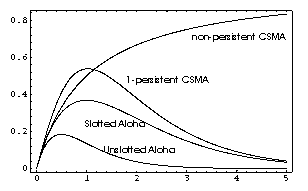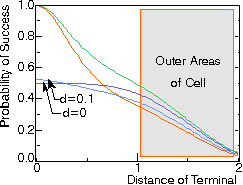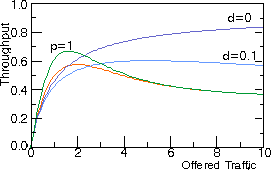
Throughput of Random Access Schemes
An important measure of performance is the throughput.
- The offered or attempted traffic, denoted as G, is the number of transmission
attempts that is made on the channel, per unit of time.
In non-persistent CSMA, attempts made when the channel is busy are inhibited.
These attempts contribute to the offered traffic.
- Throughput, denoted as S, is the
average fraction of time that the radio channel successfully carries packets.
In slotted systems, the slot length is taken as the unit of time.
In virtually all protocols (including ALOHA, CSMA, ISMA), S is approximately equal to G for small G, i.e.,
if the channel is lightly loaded.
At larger traffic loads (larger G), conflicts, called "collisions" occurs, so S < G
| |

|
Figure: Throughput S [in packets per unit of time] versus attempted traffic
G for slotted ALOHA, unslotted ALOHA, non-persistent CSMA and 1-persistent CSMA
|
Throughput Analysis
Non-persistent CSMA / ISMA is the only curve for which
S does not reduce to zero for large G.
If terminals can indeed infinitely fast sense the channel, as is assumed here, collisions can be avoided completely.
Note that the average number of (re-) transmission attemps only equals G/S
in a stable system. Stability is problematic is retransmission waiting times are short in a network with many terminals.
 Mathematica Source Code
Mathematica Source Code
Plot[{G Exp[-G], G Exp[-2 G], G /(1+G),
(G + G*G) / (1 + G * Exp[G])}, {G, 0, 5 },
Frame -> True]
Performance over wireless channels
In a wireless channel performance differs substantially from the
performance over cable Local area Network.
- Packets may be lost due to fading even if no collision occur
- If collisions occur not all packet involved are lost. Some may nonetheless
be detected successfully, particularly if these are received with strong power.
This effect is called capture.
The following figures compare various random access methods for the following set of parameters
and assumptions:
- Average message arrival and retransmission rate: 1 packet per unit of time.
- Terminals
quasi-uniformly distributed over cell, with cell boundary approximately at unity distance.
- Receiver threshold 6 dB.
- Plane earth loss (40 log d)
and slow, narrowband Rayleigh fading.
- Median signal-to-noise ratio (for user at distance 0.734)
is 20 dB.
- New arrivals and retransmissions for a stationary Poisson process. The network is stable. Theoretically, this condition can only
be satisfied if the retransmission backoff delay is infinitely large.
| |

|
Figure: Probability that an access attempt is successful
versus the distance between terminal and base station.
- orange: slotted ALOHA
- blue: non-persistent ISMA, with signalling delay d. The attempt may fail
if the terminal is inhibited.
- green 1-persistent ISMA
|
|
|
|
| |

|
Figure: Throughput (in packet per unit of time)
versus attempted traffic.
|
|
The above curves suggest that the mobile channel gives a better performance than the (wired) channel with capture.
This is due to the capture effect.







 Mathematica Source Code
Mathematica Source Code
